
The Enchanting Plitvice Lakes National Park
Discover the breathtaking beauty of Plitvice Lakes National Park in Croatia, a UNESCO World Heritage site featuring cascading waterfalls, crystal-clear lakes, and lush forests.
Plitvice Lakes National Park is one of Croatia's most beautiful and popular tourist destinations. Located in the heart of the country, this UNESCO World Heritage site is known for its cascading waterfalls, crystal-clear lakes, and lush green forests. The park covers over 29,000 hectares and features 16 interconnected lakes, which are divided into the Upper and Lower Lakes. Each lake is a different shade of blue or green, making for an enchanting and colorful landscape. Visitors to Plitvice Lakes National Park can enjoy a variety of activities, including hiking, boat rides, and guided tours. There are several well-maintained trails that range from easy to challenging, allowing visitors to explore the park at their own pace. The wooden walkways and bridges provide stunning viewpoints and allow you to get up close to the waterfalls and lakes. For those interested in wildlife, the park is home to a diverse range of animals, including deer, bears, wolves, and many bird species. One of the highlights of visiting Plitvice Lakes is experiencing the changing seasons. In spring, the park comes to life with blooming flowers and vibrant greenery. Summer offers warm weather and the perfect conditions for exploring the park's many trails. Autumn brings a spectacular display of red, orange, and yellow foliage, while winter transforms the park into a snowy wonderland with frozen waterfalls and serene landscapes. No matter the season, Plitvice Lakes National Park offers breathtaking scenery and unforgettable experiences.
Local tips in Plitvice Lakes National Park
- Visit early in the morning or late in the afternoon to avoid crowds and enjoy a more peaceful experience.
- Wear comfortable walking shoes, as the park's trails can be uneven and slippery, especially near the waterfalls.
- Bring a packed lunch and plenty of water, as there are limited dining options within the park.
- Plan your visit for the off-season (spring or autumn) to enjoy the park's beauty without the peak-season crowds.
- Check the weather forecast before your visit and dress in layers, as the weather can change quickly in the park.
- Consider staying overnight in one of the nearby accommodations to fully explore the park at a leisurely pace.
The Enchanting Plitvice Lakes National Park
Plitvice Lakes National Park is one of Croatia's most beautiful and popular tourist destinations. Located in the heart of the country, this UNESCO World Heritage site is known for its cascading waterfalls, crystal-clear lakes, and lush green forests. The park covers over 29,000 hectares and features 16 interconnected lakes, which are divided into the Upper and Lower Lakes. Each lake is a different shade of blue or green, making for an enchanting and colorful landscape. Visitors to Plitvice Lakes National Park can enjoy a variety of activities, including hiking, boat rides, and guided tours. There are several well-maintained trails that range from easy to challenging, allowing visitors to explore the park at their own pace. The wooden walkways and bridges provide stunning viewpoints and allow you to get up close to the waterfalls and lakes. For those interested in wildlife, the park is home to a diverse range of animals, including deer, bears, wolves, and many bird species. One of the highlights of visiting Plitvice Lakes is experiencing the changing seasons. In spring, the park comes to life with blooming flowers and vibrant greenery. Summer offers warm weather and the perfect conditions for exploring the park's many trails. Autumn brings a spectacular display of red, orange, and yellow foliage, while winter transforms the park into a snowy wonderland with frozen waterfalls and serene landscapes. No matter the season, Plitvice Lakes National Park offers breathtaking scenery and unforgettable experiences.
When is the best time to go to Plitvice Lakes National Park?
Iconic landmarks you can’t miss
Rastoke
Discover the enchanting village of Rastoke, where charming waterfalls and historic watermills create an unforgettable Croatian experience.
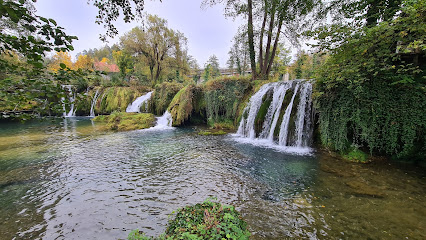
Lička kuća
Discover the authentic flavors of Croatia at Lička kuća, your perfect dining destination near Plitvice Lakes National Park.
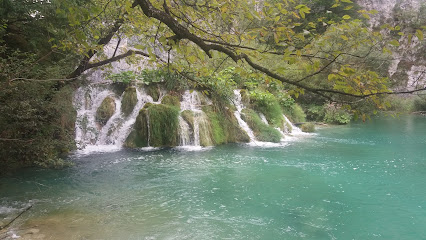
Restaurant Petar Plitvice Lakes
Experience delectable Croatian cuisine at Restaurant Petar, the ideal dining stop for Plitvice Lakes National Park visitors.

Camping Plitvice
Discover the tranquility of Camping Plitvice, your gateway to the breathtaking beauty of Plitvice Lakes National Park in Croatia.
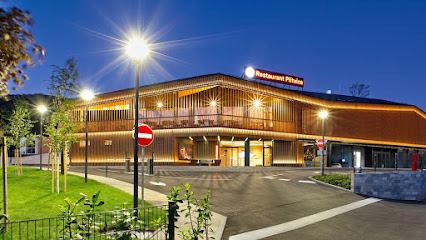
Pećinski park Grabovača
Explore the enchanting caves and rich biodiversity of Pećinski Park Grabovača, a must-visit nature preserve in Croatia for adventure and tranquility.
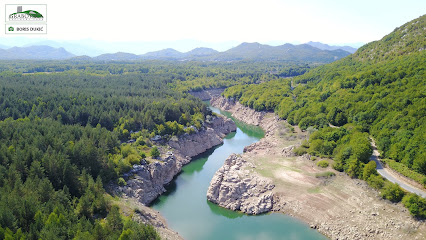
Baraćeve špilje
Explore the stunning underground wonders of Baraćeve Špilje in Croatia—an unforgettable adventure awaits in this enchanting cave system.

Great Waterfall
Discover the breathtaking Great Waterfall at Plitvice National Park, a stunning natural wonder surrounded by lush landscapes and serene lakes.

Plitvice Mall
Discover a unique shopping experience at Plitvice Mall, your gateway to the stunning landscapes of Plitvice Lakes National Park.

Plitvice Lakes Entrance 2 Parking
Experience the breathtaking beauty of Plitvice Lakes National Park from the convenient Plitvice Lakes Entrance 2 Parking, your gateway to nature's wonders.

Stari Mlin (Old Mill)
Experience the historical allure and natural beauty of Stari Mlin, a charming water mill in the picturesque village of Rastoke, Croatia.

Zipline Pazi Medo
Soar through the treetops at Zipline Pazi Medo, an exhilarating adventure amidst the stunning landscapes of Plitvice Lakes, Croatia.

Ethno Houses
Immerse yourself in the serene beauty of Plitvice Lakes while enjoying the traditional charm of Ethno Houses, your perfect lodging escape.

CAMPING PLACE BEAR Plitvički Slap d.o.o
Discover the beauty of Plitvička Jezera from Camping Place Bear, a serene campground offering comfort and adventure near Croatia's stunning national park.

Plitvice Ticket Office Entrance 1
Experience the breathtaking beauty of Plitvice Lakes National Park, a UNESCO World Heritage Site, with stunning lakes and cascading waterfalls.

Zipline Plitvice
Experience the thrill of soaring through the treetops at Zipline Plitvice, where adventure meets stunning natural beauty in Croatia.

Unmissable attractions to see
Rastoke
Discover the enchanting village of Rastoke, where cascading waterfalls meet rich cultural heritage in the heart of Croatia.
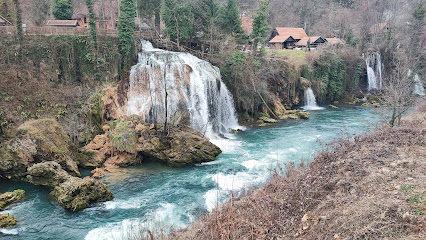
Nacionalni park Una
Discover the breathtaking waterfalls and pristine landscapes of Nacionalni Park Una, a true gem in Bosnia and Herzegovina's natural heritage.

Pećinski park Grabovača
Explore the natural beauty and stunning caves of Pećinski Park Grabovača, a unique tourist attraction in Croatia perfect for nature lovers and adventurers.

Stari Mlin (Old Mill)
Discover the charm of Stari Mlin, a historic water mill in Rastoke, Croatia, surrounded by stunning waterfalls and lush landscapes.

Zipline Pazi Medo
Discover the thrill of ziplining at Zipline Pazi Medo in Vrhovine, Croatia - an adventure sports destination with breathtaking views and family-friendly fun.

Office of Una NP
Experience the breathtaking beauty and adventure of Una National Park, a natural treasure in Bosnia and Herzegovina filled with stunning landscapes and thrilling activities.

River Slunjčica Spring
Experience the breathtaking beauty of River Slunjčica Spring, a serene natural attraction in Slunj, Croatia, perfect for relaxation and outdoor adventures.

Yeti Cabin Plitvice Lakes
Discover the serene beauty of Plitvice Lakes at Yeti Cabin, your perfect retreat for adventure and relaxation in Croatia's natural wonderland.
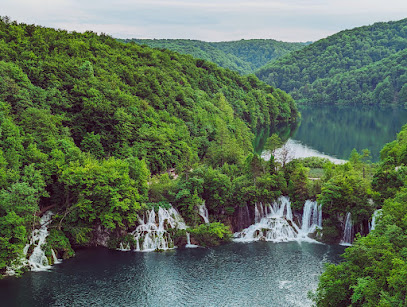
Vidikovac 5
Discover the stunning vistas and serene beauty at Vidikovac 5, a must-visit tourist attraction in Rastovača, Croatia.

Parkplatz Plitvicer Seen
Explore the breathtaking beauty of Plitvice Lakes National Park, Croatia's stunning UNESCO World Heritage Site filled with cascading lakes and lush forests.

IVA
Discover the breathtaking natural beauty and diverse wildlife at IVA Ecological Park in Plitvička Jezera, a true haven for nature enthusiasts.

Mlinica - Old mill
Explore Mlinica - Old Mill in Čatrnja, a serene tourist attraction blending history and nature for a memorable escape.

Niepubliczne kąpielisko
Experience tranquility and natural beauty at Niepubliczne kąpielisko in Čatrnja, a perfect retreat for relaxation and outdoor fun.

Mrsinj Grad
Explore the serene trails of Mrsinj Grad, a hiking paradise in Vrelo Koreničko, Croatia, where nature and history intertwine beautifully.

Alexandar Vacation Lodge - Croatia Plitvice Lakes
Experience the beauty of Plitvice Lakes at Alexandar Vacation Lodge—your gateway to nature's wonders and hiking adventures.

Essential places to dine
Degenija
Discover authentic Croatian flavors at Degenija, a top-rated restaurant near Plitvice National Park offering delicious dishes in a beautiful setting.

Vila Velebita
Experience authentic Croatian cuisine at Vila Velebita in Korenica - a delightful stop near Plitvice Lakes National Park.

Pizzeria Vučnica
Savor authentic pizza at Pizzeria Vučnica near Plitvička Jezera National Park—where every slice tells a story of flavor.
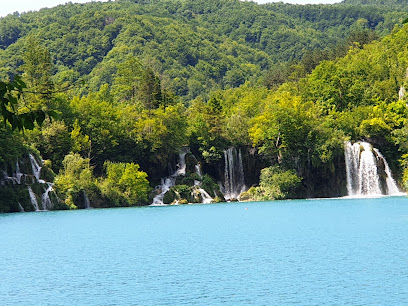
Lička kuća
Discover authentic Croatian flavors at Lička kuća near Plitvice Lakes National Park, where tradition meets taste in every dish.

Restaurant Petar Plitvice Lakes
Discover authentic Croatian cuisine at Restaurant Petar near Plitvice Lakes National Park - a culinary gem in nature's embrace.

Fast Food BBQ
Experience the best of barbecue and American cuisine at Fast Food BBQ in Rakovica - where flavor meets fun!
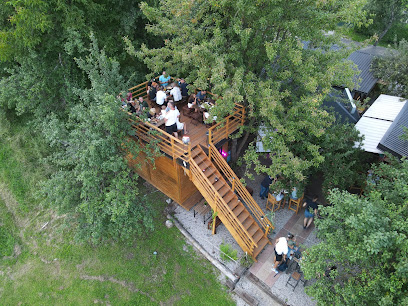
Restoran Gurman
Experience authentic Croatian cuisine at Restoran Gurman near Plitvice Lakes National Park - a culinary gem for every traveler.

Restoran Šapina
Experience authentic Croatian cuisine at Restoran Šapina in Korenica—perfectly situated near Plitvice Lakes National Park.

Restoran Babić
Experience authentic Croatian cuisine at Restoran Babić near Plitvice Lakes National Park - where tradition meets flavor.

Restaurant Borje
Experience the flavors of Croatia at Restaurant Borje - where culinary excellence meets nature's beauty near Plitvice Lakes.

Poljana
Experience authentic Croatian cuisine at Poljana Restaurant in Plitvička Jezera National Park amidst stunning natural landscapes.

Restoran Plitvički Dvori
Experience authentic Croatian cuisine at Restoran Plitvički Dvori near the majestic Plitvice Lakes, where tradition meets flavor.

Plitvice Holiday Resort Restaurant ATG
Experience authentic Croatian cuisine amidst stunning natural beauty at Plitvice Holiday Resort Restaurant.

Bistro Winnetou
Experience authentic Croatian flavors at Bistro Winnetou near Plitvice Lakes National Park - a perfect blend of dining and hospitality.

Restaurant Plitvice
Experience authentic Croatian cuisine at Restaurant Plitvice near the stunning national park.

Markets, malls and hidden boutiques
Plitvice Lakes National Park
Explore the enchanting Plitvice Lakes National Park, a UNESCO World Heritage site with breathtaking lakes, waterfalls, and diverse wildlife.
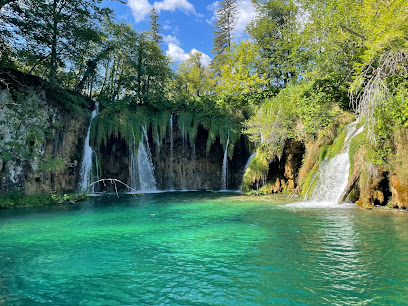
Great Waterfall
Experience the breathtaking beauty of the Great Waterfall, a stunning showcase of nature's artistry in Plitvice Lakes National Park.

Plitvice Lakes Entrance 2 Parking
Discover the breathtaking beauty of Plitvice Lakes National Park from the convenient Plitvice Lakes Entrance 2 Parking, your gateway to Croatia's natural gem.

Plitvice Mall
Explore Plitvice Mall - A vibrant shopping haven near Plitvice Lakes, offering diverse stores, delightful eateries, and family-friendly entertainment.

Ethno Houses
Discover the enchanting Ethno Houses in Plitvička Jezera, where traditional charm meets modern comfort amidst stunning natural beauty.

Tommy Maximarket
Discover the flavors of Croatia at Tommy Maximarket, your go-to supermarket in Čatrnja for fresh produce and local delicacies.

Kordun
Discover the charm of Kordun: a friendly grocery store in Rakovica, Croatia, offering local flavors and everyday essentials for every traveler.
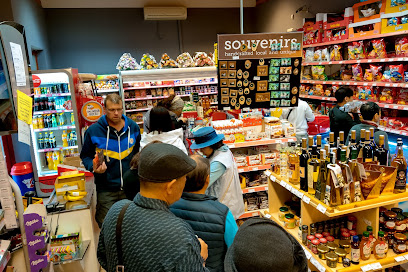
Robni Centar
Explore the beauty of Plitvička Jezera while stocking up on local delicacies and essentials at Robni Centar, your go-to supermarket.

PLITVICE ART FARM
Discover the flavors of Croatia at Plitvice Art Farm, where traditional cuisine meets family fun and unique local crafts.

Sirana Turkalj, Lika Quality
Explore the authentic flavors of Lika at Sirana Turkalj, your gateway to exquisite Croatian dairy products and experiences.

Market Ivka
Discover the flavors of Croatia at Market Ivka, your go-to grocery store in Selište Drežničko for fresh produce and local specialties.

Plitvice Lakes Etno Garden
Experience the tranquility of Plitvice Lakes Etno Garden, your gateway to nature's wonders and authentic Croatian culture.

Špoljarić Water-mill
Explore the enchanting Špoljarić Water-mill, a museum celebrating the rich heritage of traditional water-powered milling in the beautiful Korana region.
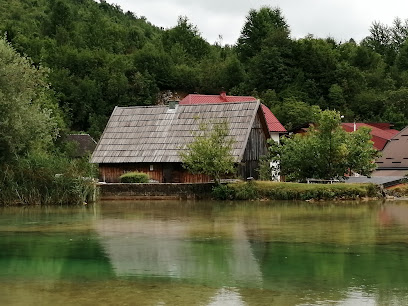
Veliki prštavac
Experience the breathtaking beauty of Veliki Prštavac Waterfall, a must-visit natural gem in Plitvička Jezera, Croatia, offering stunning views and tranquility.

Gavranovic Market
Discover the heart of Saborsko at Gavranovic Market, your go-to supermarket for fresh produce and local delicacies in Croatia.

Essential bars & hidden hideouts
Pizzeria Vučnica
Indulge in delicious wood-fired pizzas at Pizzeria Vučnica, the perfect dining spot near Plitvička Jezera's breathtaking natural beauty.

Lička kuća
Discover the essence of Croatian cuisine at Lička kuća, where traditional recipes and local flavors come together in a charming dining experience.

Restaurant Petar Plitvice Lakes
Experience the authentic tastes of Croatia at Restaurant Petar, nestled in the breathtaking Plitvice Lakes National Park.

Fast Food BBQ
Savor the best American barbecue and comfort food in Rakovica at Fast Food BBQ, where flavor meets affordability in a casual setting.

Poljana
Experience the essence of Croatian cuisine at Poljana Restaurant, nestled in the stunning Plitvička Jezera National Park.

Restoran Grand Lakes
Experience the essence of Croatian culinary tradition at Restoran Grand Lakes, surrounded by the stunning nature of Plitvička Jezera.

Kozjačka Draga
Discover Kozjačka Draga, an inviting grill restaurant in Plitvička Jezera, offering delicious local dishes amidst stunning natural beauty.
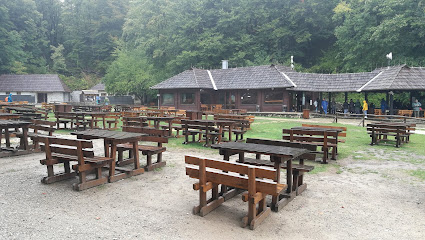
Lex Bar & Pizzeria - Plitvice Mall
Savor authentic Croatian pizza at Lex Bar & Pizzeria, located in Plitvice Mall, where taste meets tradition in a warm atmosphere.
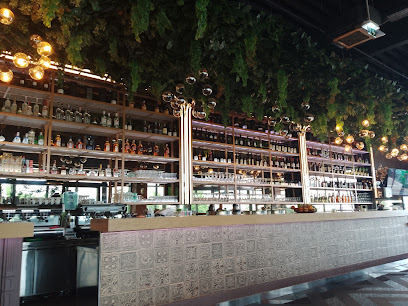
Restaurant & B&B Plitvica Lodge
Experience the tranquility of Plitvica Lodge, the perfect base for exploring the stunning Plitvice Lakes National Park and savoring local cuisine.

Bistro Kupaliste
Discover the delightful flavors of Croatia at Bistro Kupaliste, nestled in the heart of Plitvička Jezera National Park.

Restoran Antonio
Experience authentic Croatian flavors in a cozy, family-friendly setting at Restoran Antonio in Jezerce.

Cafe Rapajinka
Experience the charm of Cafe Rapajinka in Plitvička Jezera, where local flavors meet stunning natural beauty in a cozy atmosphere.

Bistro Labudovac
Experience authentic Croatian cuisine at Bistro Labudovac, a cozy diner in the heart of Plitvička Jezera, perfect for park visitors seeking local flavors.

Restoran Kozjak
Experience authentic Croatian cuisine at Restoran Kozjak, the perfect dining spot near Plitvice Lakes National Park, surrounded by stunning natural beauty.

Bistro Hladovina
Discover the perfect fast food stop at Bistro Hladovina in Plitvička Jezera, offering delicious meals amidst stunning natural beauty.

Local Phrases about Plitvice Lakes National Park
-
- HelloBok
[Bohk] - GoodbyeDoviđenja
[Doh-vee-jen-ya] - YesDa
[Dah] - NoNe
[Neh] - Please/You're welcomeMolim
[Moh-leem] - Thank youHvala
[Hvah-lah] - Excuse me/SorryOprosti
[Oh-pros-tee] - How are you?Kako si?
[Kah-koh see] - Fine. And you?Dobro. A ti?
[Doh-bro. Ah tee] - Do you speak English?Govoriš li engleski?
[Go-vo-ree-sh lee eng-les-kee] - I don't understandNe razumijem
[Neh rah-zoo-mee-yem]
- HelloBok
-
- I'd like to see the menu, pleaseMogu li vidjeti jelovnik, molim
[Moh-goo lee vee-dyeh-tee yeh-lov-neek, moh-leem] - I don't eat meatNe jedem meso
[Neh yeh-dem meh-so] - Cheers!Živjeli!
[Zhee-vyeh-lee] - I would like to pay, pleaseŽelim platiti, molim
[Zheh-leem pla-tee-tee, moh-leem]
- I'd like to see the menu, pleaseMogu li vidjeti jelovnik, molim
-
- Help!Pomoć!
[Poh-mohtch] - Go away!Idi odatle!
[Ee-dee oh-daht-leh] - Call the Police!Pozovite policiju!
[Poh-zo-vee-teh po-lee-tsee-yoo] - Call a doctor!Pozovite doktora!
[Poh-zo-vee-teh dohk-toh-rah] - I'm lostIzgubio/la sam se
[Eez-goo-byoh/lah sahm seh] - I'm illBolestan/sna sam
[Boh-les-tahn/snah sahm]
- Help!Pomoć!
-
- I'd like to buy...Želim kupiti...
[Zheh-leem koo-pee-tee] - I'm just lookingSamo gledam
[Sah-moh gleh-dahm] - How much is it?Koliko košta?
[Koh-lee-koh kohs-tah] - That's too expensiveTo je pre skupo
[Toh yeh preh skoo-poh] - Can you lower the price?Možete li spustiti cijenu?
[Moh-zheh-teh lee spoo-stee-tee tsee-yeh-noo]
- I'd like to buy...Želim kupiti...
-
- What time is it?Koliko je sati?
[Koh-lee-koh yeh sah-tee] - It's one o'clockJedan je sat
[Yeh-dahn yeh saht] - Half past (10)Pola (deset)
[Poh-lah (deh-set)] - MorningJutro
[Yoo-troh] - AfternoonPopodne
[Poh-pohd-neh] - EveningVečer
[Veh-chehr] - YesterdayJučer
[Yoo-cher] - TodayDanas
[Dah-nahs] - TomorrowSutra
[Soo-trah] - 1Jedan
[Yeh-dahn] - 2Dva
[Dvah] - 3Tri
[Tree] - 4Četiri
[Cheh-tee-ree] - 5Pet
[Peh-t] - 6Šest
[Shehst] - 7Sedam
[Seh-dahm] - 8Osam
[Oh-sahm] - 9Devet
[Deh-veht] - 10Deset
[Deh-set]
- What time is it?Koliko je sati?
-
- Where's a/the...?Gdje je...?
[Gdyeh yeh] - What's the address?Koja je adresa?
[Koh-yah yeh ah-dreh-sah] - Can you show me (on the map)?Možete li mi pokazati (na karti)?
[Moh-zheh-teh lee mee poh-kah-zah-tee (nah kahr-tee)] - When's the next (bus)?Kada je sljedeći (autobus)?
[Kah-dah yeh slyeh-deh-chee (ow-toh-boos)] - A ticket (to ....)Jednu kartu (do ....)
[Yehd-noo kahr-too (doh)]
- Where's a/the...?Gdje je...?
History of Plitvice Lakes National Park
-
The Plitvice Lakes were formed over thousands of years through natural geological processes. The area is characterized by tufa barriers, which were created by the deposition of calcium carbonate from water flowing over obstacles. This natural phenomenon resulted in the creation of a complex network of 16 interconnected lakes, each separated by natural dams, cascading into one another via waterfalls and streams.
-
Evidence of human presence in the Plitvice Lakes area dates back to prehistoric times. Archaeological findings suggest that the region was inhabited by Illyrian tribes, followed by Romans who capitalized on its strategic location. The area’s natural resources and beauty have long attracted settlers and travelers alike.
-
During the medieval period, the Plitvice Lakes region fell under the control of the Croatian Kingdom. The area served as a natural fortress and refuge during times of conflict. The dense forests and rugged terrain provided protection and sustenance to local populations.
-
The 16th and 17th centuries saw the Plitvice Lakes area become a battleground between the Ottoman Empire and the Habsburg Monarchy. The region's strategic importance meant it was frequently contested, leading to the construction of fortifications and the establishment of military outposts.
-
In 1949, Plitvice Lakes was officially designated as a national park by the government of Yugoslavia. This marked a significant milestone in the preservation of its unique natural landscape and biodiversity. The park quickly became a popular destination for both domestic and international tourists.
-
In 1979, Plitvice Lakes National Park was inscribed on the UNESCO World Heritage List. This recognition was due to its exceptional natural beauty and the geological and ecological processes that have shaped its landscape. The designation has helped to ensure the park's protection and international acclaim.
-
During the early 1990s, the Plitvice Lakes region was affected by the Croatian War of Independence, also known as the Homeland War. The park saw significant conflict, including the Plitvice Lakes incident in 1991, which was one of the first confrontations of the war. The area was heavily mined, and it took years for the park to recover fully.
-
Following the end of the Homeland War, extensive efforts were made to restore and conserve Plitvice Lakes National Park. Demining operations, infrastructure repairs, and ecological restoration projects were undertaken to return the park to its former glory. Today, it stands as a symbol of resilience and natural beauty.
Plitvice Lakes National Park Essentials
-
Plitvice Lakes National Park is located in central Croatia. The nearest major airports are Zagreb (140 km away), Zadar (130 km away), and Split (230 km away). From these cities, you can reach the park by rental car, bus, or organized tours. Buses run regularly from Zagreb, Zadar, and Split to the park's entrances, and the journey typically takes between 2-3 hours.
-
Once at Plitvice Lakes, transportation within the park is mainly on foot. The park features well-marked trails and boardwalks. Electric boats and shuttle buses are available to help visitors navigate between different sections of the park. For those looking to explore the surrounding areas, renting a car is advisable. Public buses also connect the park to nearby towns and cities.
-
The official currency in Croatia is the Croatian Kuna (HRK). Credit cards are widely accepted at hotels, restaurants, and shops within and around the park, but it is advisable to carry some cash for smaller transactions, such as entrance fees or local markets. ATMs are available at the park entrances and in nearby towns.
-
Plitvice Lakes National Park is a generally safe destination for tourists. However, it is important to stay on marked trails and boardwalks to avoid accidents, as the terrain can be slippery and uneven. Keep an eye on your belongings, especially in crowded areas. There are no specific high-crime areas targeting tourists, but standard travel precautions should always be taken.
-
In case of an emergency, dial 112 for immediate assistance, which is the European emergency number. The park has several first aid stations located at the main entrances and key points within the park. It is recommended to have travel insurance that covers medical emergencies. For minor health issues, there are pharmacies in nearby towns such as Korenica and Rakovica.
-
Fashion: Do wear comfortable walking shoes and weather-appropriate clothing. Don't wear flip-flops or high heels as the terrain can be challenging. Religion: Do respect local customs if visiting religious sites nearby. Cover shoulders and knees. Public Transport: Do use public transportation options to reach the park if you do not have a rental car. Don't forget to validate your bus ticket. Greetings: Do greet locals with a friendly 'Dobar dan' (Good day). A handshake is also common. Eating & Drinking: Do try local cuisine at restaurants around the park. Don't litter; always use designated trash bins to keep the park clean.
-
To experience Plitvice Lakes like a local, visit during the off-peak seasons (spring and autumn) to avoid crowds and enjoy the park's natural beauty. Engage with local tour guides who can provide insights into the park's history and ecology. Don't miss the opportunity to try local dishes such as 'peka' (a traditional meat and vegetable dish) at nearby rural restaurants. Consider staying in a local guesthouse or 'sobe' (private room) for a more authentic experience.
Trending Landmarks in Plitvice Lakes National Park
-
Rastoke
-
Lička kuća
-
Restaurant Petar Plitvice Lakes
-
Camping Plitvice
-
Pećinski park Grabovača
-
Baraćeve špilje
-
Great Waterfall
-
Plitvice Mall
-
Plitvice Lakes Entrance 2 Parking
-
Stari Mlin (Old Mill)
-
Zipline Pazi Medo
-
Ethno Houses
-
CAMPING PLACE BEAR Plitvički Slap d.o.o
-
Plitvice Ticket Office Entrance 1
-
Zipline Plitvice
Nearby Cities to Plitvice Lakes National Park
-
Things To Do in Zadar
-
Things To Do in Zagreb
-
Things To Do in Opatija
-
Things To Do in Banja Luka
-
Things To Do in Pula
-
Things To Do in Jajce
-
Things To Do in Postojna
-
Things To Do in Rogaška Slatina
-
Things To Do in Rovinj
-
Things To Do in Celje
-
Things To Do in Ljubljana
-
Things To Do in Trogir
-
Things To Do in Sežana
-
Things To Do in Koper
-
Things To Do in Split












